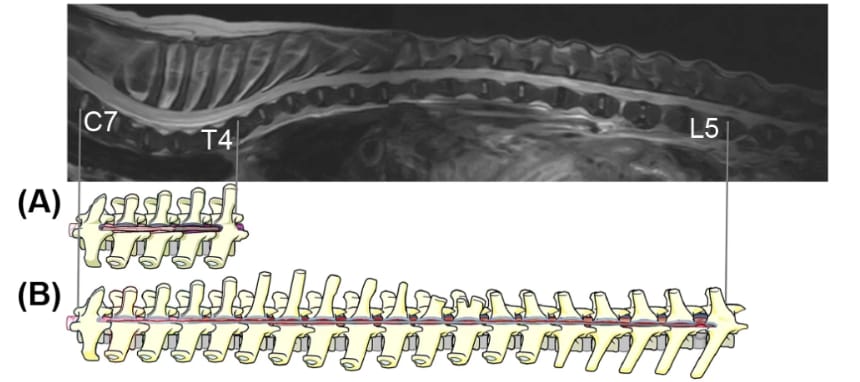- Veterinary View Box
- Posts
- Saving Lives, Not Limbs: Limited-Scope Durotomy Offers a Safer Option for Dogs with Suspected PMM
Saving Lives, Not Limbs: Limited-Scope Durotomy Offers a Safer Option for Dogs with Suspected PMM
BMC Veterinary Research, 2025
Yuya Nakamoto, Kyosuke Hidari, Mei Matsuo, Miwa Nakamoto
Background
Progressive myelomalacia (PMM) is a fatal, ascending/descending necrosis of the spinal cord that can develop in dogs following thoracolumbar intervertebral disc extrusion (TL-IVDE), especially in those with paraplegia and loss of deep pain perception. Previous studies suggest that extensive hemilaminectomy and durotomy (EHLD) may improve survival in presumptive PMM by decompressing affected spinal cord segments. However, EHLD entails long surgeries and large wounds. This study evaluated a modified, cranial-limited approach (EHLD-L) to determine whether it can provide comparable survival outcomes with reduced surgical burden.
Methods
In this retrospective cohort study, 12 dogs with TL-IVDE and MRI-confirmed intramedullary T2-weighted hyperintensity (T2 length ratio ≥ 6) underwent either EHLD (n = 5) or EHLD-L (n = 7). In EHLD-L, decompression extended from the cranial boundary of the T2W hyperintensity down to visible spinal swelling or softening, without addressing the disc extrusion site. Postoperative survival, hemilaminectomy window length, and surgical time were compared. Follow-ups included physical exams and phone consultations over a median of 387 days (EHLD-L) and 755 days (EHLD).
Results
Survival at one month was 100% for EHLD and 86% for EHLD-L (one death from bladder rupture unrelated to PMM). No dog regained pelvic limb function or urinary continence in either group. Median hemilaminectomy length was significantly shorter for EHLD-L (4 vertebrae) than EHLD (10 vertebrae) (p = 0.0076), and median surgery duration was shorter (106 vs. 192 minutes; p = 0.030). No major postoperative complications occurred. All surviving dogs remained alive and stable without signs of ascending PMM during follow-up.
Limitations
The study was limited by its small sample size, retrospective design, lack of randomization, and absence of histopathologic confirmation of PMM. Low-field MRI was used, which may reduce diagnostic precision. Gross intraoperative diagnosis of spinal cord malacia may be subjective. Selection bias and reliance on clinical imaging criteria may have influenced group allocation and outcomes.
Conclusions
Cranial-limited EHLD (EHLD-L) achieves comparable survival outcomes to full EHLD while significantly reducing surgery duration and invasiveness. Although neither technique restored neurologic function, both may halt PMM progression and preserve life. EHLD-L may be a practical alternative for dogs with suspected PMM, especially when owners are willing to manage long-term paraplegia and incontinence. Further studies with larger cohorts are needed to refine surgical indications and assess long-term outcomes.

Schematic depiction comparing EHLD-L with that after EHLD performed hypothetically in the same dog. Surgical image of an EHLD-L method in a dog (no. 5). (A) EHLD-L was performed from the site of the cranial region with intramedullary hyperintensity on T2W-MRI toward the caudal site until the spinal cord with swelling or softening was visible (C7–T4). (B) If EHLD, as previously reported, is applied, spinal decompression from C7 to L5 is required
How did we do? |
Disclaimer: The summary generated in this email was created by an AI large language model. Therefore errors may occur. Reading the article is the best way to understand the scholarly work. The figure presented here remains the property of the publisher or author and subject to the applicable copyright agreement. It is reproduced here as an educational work. If you have any questions or concerns about the work presented here, reply to this email.